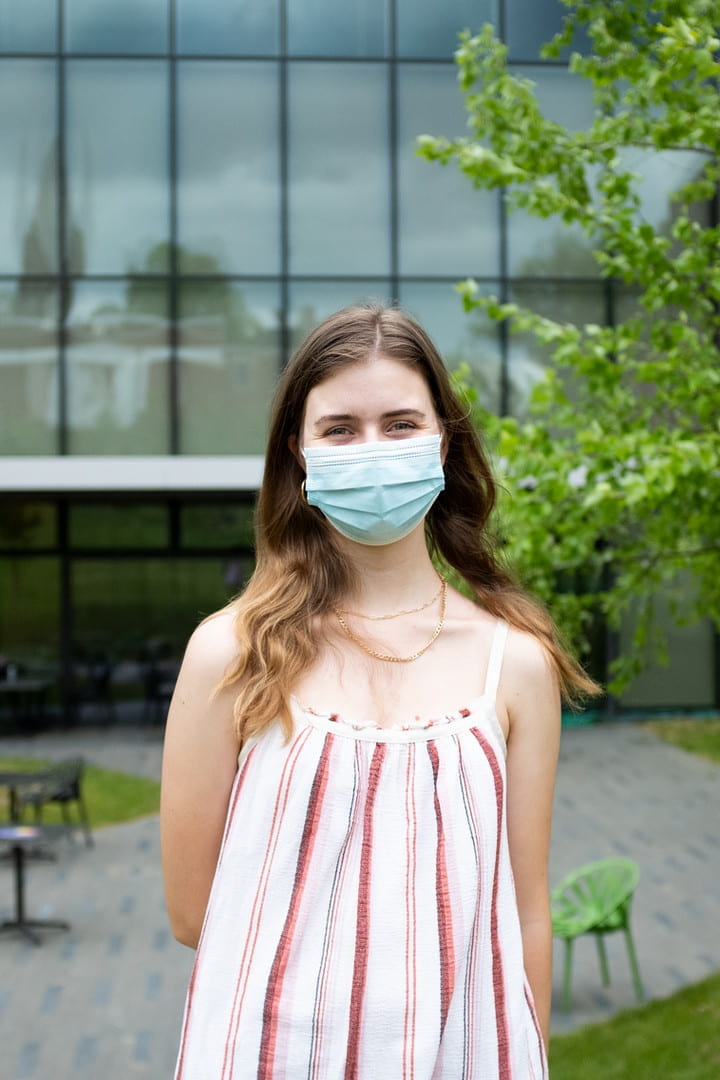
The following was adapted from a Zoom interview between Sarah Lapean and Annika Lunstad.
Annika is a physics and math double major. She came to Amherst wanting to study physics, but without a clear idea of where she wanted to go with it. The summer after her freshman year, she participated in the Summer Science Undergraduate Research Fellowship (SURF) with Professor David Hanneke. She really enjoyed her project, which involved building laser shutters from computer hard drive motors. The hard drive would block lasers automatically, so they could keep track of the wavelengths of multiple lasers. She got to learn about the machine shop, electronics, programming, and optics. This experience introduced her to the field of atomic, molecular, and optical (AMO) physics, in which “you can learn a million different things in pursuit of this one goal.” She had a wonderful experience with Professor Hanneke, who “really prioritized learning,” and whom she has continued to work with almost continuously since then.
Professor Hanneke’s lab is what is called a precision measurements lab in AMO. It conducts fundamental physics experiments, which means they are trying to understand some of the fundamental forces, particles, and general laws about the universe. The way a “table-top physics experiment” fits into this is that they can look for very small changes in a low energy environment that would be caused by physics beyond the Standard Model. The fundamental constant (μ) is the proton to electron mass ratio, and it is a unitless value that shows up everywhere in nature. Some theories of physics, however, have been going beyond the Standard Model that provides us with the explanation for particles we already understand, like the μ.“Instead of [μ] being a constant, it might drift in time or it might oscillate,” Annika proposes. This shift might be caused by a number of things, such as dark energy, or could be explained by theories of quantum gravity, or theories of dark matter. In order for Annika to find this slight variation in the constant, she needed a system that was sensitive to this constant.
This is where we get to the specifics of Annika’s thesis. She is looking at vibrational levels in oxygen molecules, which essentially depend on her interest in the constant μ. With the specific system she used, they intended to measure these energy levels with such precision that she might be able to look for shifts or oscillations. Quantum mechanics explain that all these energy levels are discreet. Therefore, you can drive transitions from the lowest vibrational state to a higher vibrational state, and the energy levels of these transitions would be measurable. Annika tells us that “[her] thesis was doing some of the first real searches for these transitions.”
With such a task, Annika’s daily work was far from boring. At the beginning of the semester, she was building an electrode setup. She would meet up with her advisor and spot weld some electrodes, then assemble a vacuum chamber. Later on in the semester, she moved to actually scanning her laser across the frequencies where she would expect to drive the transitions. Towards the end of her thesis, she would wake up in the morning, adjust the laser by realigning it or adding dye (bright purple!), get everything set up, then decide what she wanted to look at that day, which was the hardest part. She would choose which frequencies she would scan, how many data points she would take at each step, then run the scan. Later, she would check back in on it, shut everything down at the end of the day, and try to interpret the results. This is what Annika loves about the field of physics – the wide range of things you get to do.
Annika considers herself and her lab as a part of a larger project of the broader physics community. She knows they aren’t the only lab looking for changes in μ, or even the only one using oxygen to find these changes. The broad goal of looking for these changes in the fundamental constant is a community effort to work out technical problems.
Next year, Annika will be attending graduate school at Harvard University, where she will continue to look for these shifts with a polyatomic molecule. Her advice for freshmen and sophomores is to try working in different kinds of labs to get “a flavor for different kinds of research” and to meet different professors. If you are just about to start your thesis, Annika advises that you try to limit the number of other things you focus on during your senior year. Give yourself a ton of space, and make yourself a priority.

You must be logged in to post a comment.